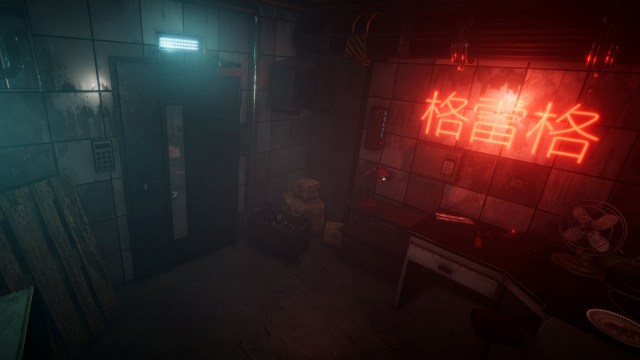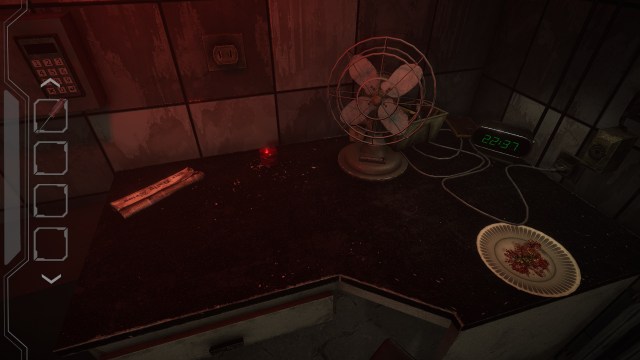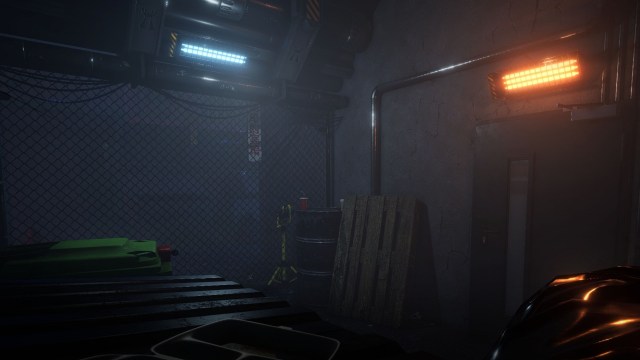What’s the collective noun for escape rooms? A lock-in of escape rooms? A Hellraiser? Whatever it is, we’ve been getting them on the Xbox Store recently. And that’s been down to one developer: OnSkull Development IKE have been porting their long list of PC escape rooms to the black box, and they’ve got yet more to come.
Picking one from random to start off our reviews, we have Escape 2088. We presume that the 2088 has been slapped on the end there because Escape 2088 is meant to be futuristic, cyberpunk or whatever, but – to be brutally honest – it’s about as futuristic as popping down a laser tag in the early 2000s. There are some neon signs, the paint is peeling off the walls, and there is the odd computer. We’re not quite into Cyberpunk 2077 territory.
But we’re game. We like a spot of escape rooming. In that, when we cross the threshold into an actual, physical escape room, we get incredibly competitive and believe we’re Benedict Cumberbatch in our Mind Palace. If we ask for a hint or go over the time, it’s the end of the world.

We’ve played enough OnSkull Development IKE escape rooms on the Xbox to know this one is a little bit different. There is no multiplayer, competitive or cooperative, so you are left to play this entirely solo. There’s a knock-on effect here, as it also means that you only have to play once to get all the achievements, making it more attractive to Gamerscore hounds.
You can see why multiplayer was stripped out of this one. Rather than have you walking around a space with full freedom of movement, you are pivoting about a single spot in the middle of each room. That wouldn’t work if there were two people in the room, for obvious reasons, so you get to do this one solo.
We will be brutally honest: it improves things. As much as we like the concept for multiplayer escape rooms on the Xbox, we’ve not enjoyed the OnSkull versions. As we’ll explain in other reviews, they are extremely fiddly, unfair and prone to causing confusion, and that’s not exactly date-night material. So, stripping out the multiplayer didn’t bother us at all. Being chained to a single point in the room also helps things: the game can be designed around us, making everything graspable. In the other games, moving about the area can mean whacking your shins and head against drawers and cupboard doors.
Escape 2088 is three rooms, one after the other. We’d say that it’s slightly bigger than an escape room that you might do on the high street, but not by much. It’s designed to be done in less than an hour, and the price is a mere £2.49, so you can see OnSkull’s business model at work here. These are short, to-the-point escape rooms for a low price. We’d say that it’s a fair offer.
Jumping into the first room (and then getting locked into place), you will immediately feel the trademark jankiness of these games. We’ll put partial blame on them being PC first and then ported to console later, but we suspect that they’re full of jank there, too. The camera is controlled with the right analogue-stick, giving you a full 360 view, and you can move a tiny mouse cursor with the left analogue-stick. This is what you use to highlight, pick up, tap and move things. There’s mouse and keyboard functionality, but we weren’t able to test it ourselves.

Request #1 for future escape rooms. That cursor needs an overhaul. Let’s give it a makeover: it needs to be bigger, for one. Scale it up twice over, so we can actually see the thing. Okay, now let’s make it context-sensitive, changing according to the things you can do with it. We know why you haven’t made this change, OnSkull: you want to preserve the immersion and integrity of the escape room, but let’s be honest, your puzzles are on the extremely difficult end anyway, and you’ve already tossed a mouse cursor onto the screen so immersion has gone out of the window regardless. We want the mouse to be telling us if something is interactable or not. We want to know if something should be merely prodded, opened, lifted up or slides across. The cursor should tell us these things.
Without them, the room presents itself as a static scene when it’s actually got lots of knobs and dials for you to fiddle with. That fan button? It’s not actually a button, even though it looks like one. You can hold the interaction button and slide that bad boy to the left and right. The same goes for plugs you can yank out of sockets, and cushions you can lift off seats. The world lets you do more than you think, but they can’t expect people to spend the whole day yanking everything this way and that.
Request #2. If there’s cause and effect, shout about it. It’s entirely possible to be successful in Escape 2088. You can push a switch, complete a puzzle or any other action and the room will change. Something over the other wall will open or power up. But Escape 2088 won’t tell you. It will barely give you a positive audio sound to show that something changed. It’s entirely possible to think that you have failed, and look elsewhere for a solution.
Request #3 is to stop being so obscure. Everything we’ve mentioned is already a handicap, yet they are partnered with puzzles that are so opaque that you often won’t realise they’re puzzles in the first place. Keypads litter the rooms, with no indication of the puzzle they correspond to. So, find a solution, and you’ll be typing it everywhere. We don’t exactly feel like a cyberpunk Indiana Jones.
You’d have to be a professional triple-jumper to make it over some of the logical leaps. A 1, 3, 7 and 11 in a cabinet? Oh, that must relate to a poster on a different wall, which has numbers integrated into it, and you have to find the 1st, 3rd, 7th and 11th of those numbers! Right? Right? It’s a strong emblem of what is wrong with OnSkull logic: first, it’s hard to know which element in the room the numbers refer to. Second, those numbers could apply to the poster in any number of ways. Perhaps the numbers identify the letters on the poster? Perhaps the numbers are a code by themselves? There are just too many permutations.

The result, as with so many OnSkull escape rooms, is that you get as far as you can and then reach for a guide. We’d throw the gauntlet down to anyone who reads this review: if you can complete the escape room in the given time without hints, on the first go, let us know in the comments. We are willing to bow down to your majesty.
On that note, Escape 2088 is better than most in the series. The rooms are concise, and being locked in place means you’re not chasing gooses in the wrong rooms. The solution is in front of you, as long as you yank, slide or use the write item on it. For every obtuse creation of a magnet, there are simple puzzles where you are merely matching colours between a key and a lock. Roughly two-thirds of the puzzles can be completed by humans, while the other third will be luck or the use of walkthroughs. Which is slightly better-than-par for the OnSkull series.
Oh, how we longed for Escape Academy. Where that game felt like it was created by game designers for normal people, Escape 2088 feels like it was created by that Jigsaw guy from the Saw series. And it’s not even the most arduous escape room in the OnSkull series. Painful to control, unhelpful in the extreme, and stacked with puzzles that make only the loosest sense, this feels like the most punishing boot camp for escape room fans.
You can buy Escape 2088 from the Xbox Store
TXH Score
2.5/5
Pros:
- One of the more forgiving OnSkull escape rooms
- 1000G for an hour’s work
- Cheap as chips
Cons:
- Desperately needs some control improvements
- Mouse cursor could be more helpful
- Puzzles are demonic
Info:
- Massive thanks for the free copy of the game go to – Purchased by TXH
- Formats – Xbox Series X|S, Xbox One
- Version reviewed – Xbox One on Xbox Series X
- Release date – 2 February 2023
- Launch price from – £2.49
- SEO Powered Content & PR Distribution. Get Amplified Today.
- Platoblockchain. Web3 Metaverse Intelligence. Knowledge Amplified. Access Here.
- Source: https://www.thexboxhub.com/escape-2088-review/
- 100
- 11
- 7
- About
- according
- achievements
- across
- Action
- Against
- AI
- All
- arduous
- AREA
- around
- as
- attractive
- audio
- because
- believe
- Better
- between
- bigger
- Bit
- Black
- Box
- business
- business model
- button
- buy
- Camp
- Cause
- change
- code
- comments
- Competitive
- complete
- computer
- concept
- confusion
- Console
- content
- Control
- controlled
- cooperative
- could
- created
- Cyberpunk
- date
- day
- designed
- designers
- Developer
- Development
- different
- difficult
- down
- Early
- Effect
- emblem
- enjoyed
- entirely
- Every
- everything
- Everywhere
- exactly
- expect
- explain
- extreme
- extremely
- Failed
- fair
- fans
- February
- First
- first place
- Free
- Freedom
- front
- full
- functionality
- future
- futuristic
- game
- Games
- getting
- given
- Giving
- guide
- Hard
- head
- helps
- here
- High
- Highlight
- hold
- How
- HTTPS
- Humans
- identify
- immediately
- immersion
- incredibly
- Indiana
- indication
- integrated
- interaction
- IT
- Key
- Keyboard
- laser
- List
- Little
- locked
- logical
- Long
- Low
- Luck
- make
- Making
- merely
- Middle
- might
- model
- more
- move
- movement
- moving
- multiplayer
- needs
- Neon
- normal
- number
- numbers
- obvious.
- Odd
- offer
- Okay
- One
- open
- Other
- Overhaul
- paint
- PC
- People
- physical
- pick
- place
- plato
- plato data intelligence
- platodata
- platogaming
- play
- Point
- Positive
- possible
- power
- presents
- price
- professional
- purchased
- push
- Puzzle
- quite
- Rating
- reach
- reasons
- recently
- regardless
- result
- review
- Reviews
- right
- room
- Rooms
- roughly
- Scale
- Screen
- sense
- Series
- Short
- Signs
- Simple
- So
- Solo
- solution
- something
- Space
- spend
- Spot
- stacked
- start
- store
- street
- strong
- successful
- Switch
- Tap
- test
- The
- The Game
- the world
- themselves
- thing
- things
- third
- time
- tossed
- trademark
- up
- us
- versions
- View
- walking
- What
- What is
- WHO
- willing
- Work
- world
- write
- X
- xbox
- Xbox One
- xbox series
- Xbox Series X
- Xbox Series X|S
- zephyrnet











